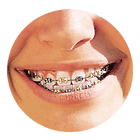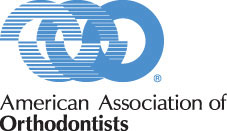- What is Orthodontics?
- What is an Orthodontist?
- What Causes Orthodontic Problems?
- Why is Treatment So Important?
- Why Should All Kids Get an Orthodontic Check-Up No Later than Age 7?
- What If My Child Is Older?
- Is it Ever Too Late to Get Started?
- What Does Treatment Involve?
- How Long Does Treatment Take?
- How much does Orthodontic Treatment Cost?
Orthodontics is the branch of dentistry that is officially known as Orthodontics and Dentofacial Orthopedics. The purpose of orthodontics is to treat any type of malocclusion, which is simply another way of saying “bad bite.”
When you have a malocclusion, that means your teeth, lips and/or jaws don’t line up the way they should. As a result, your teeth may be crooked, your bite may not work correctly and your jaws may look unbalanced.
To fix bad bites, orthodontists — dentists who are specially trained — use braces and other corrective procedures, including materials often called “appliances,” to achieve tooth and jaw alignment. This correction of the teeth and their supportive structures makes for a healthy, attractive smile.
An orthodontist is a specialist in the diagnosis, prevention and treatment of dental and facial irregularities. All orthodontists are dentists, but only about six percent of dentists are orthodontists. Admission to orthodontic programs is extremely competitive and selective.
It takes many years to become an orthodontist and the educational requirements are demanding.
An orthodontist must complete college requirements before starting a three-to-five-year graduate program at a dental school accredited by the American Dental Association (ADA). After dental school, at least two or three academic years of advanced specialty education at an ADA-accredited orthodontic program are required to be an orthodontist. The demanding program includes advanced education in biomedical, behavioral and basic sciences. The orthodontic student learns the complex skills required to manage tooth movement (orthodontics) and guide facial development (dentofacial orthopedics).
Only dentists who have successfully completed these advanced specialty education programs may call themselves orthodontists.
What Causes Orthodontic Problems?
 Most orthodontic problems are inherited. Examples of these genetic problems are crowding, spacing, protrusion, extra or missing teeth and some jaw growth problems.
Most orthodontic problems are inherited. Examples of these genetic problems are crowding, spacing, protrusion, extra or missing teeth and some jaw growth problems.
Other malocclusions are acquired. In other words, they develop over time. They can be caused by thumb- or finger-sucking, mouth breathing, dental disease, abnormal swallowing, poor dental hygiene, the early or late loss of baby (primary) teeth, loss of permanent teeth, accidents, poor nutrition, or some medical problems.
Sometimes, an inherited malocclusion is complicated by an acquired problem. But, whatever the cause, we are usually able to treat most conditions successfully.
Why is Treatment So Important?
Crooked and crowded teeth are hard to clean and maintain. Such problems can contribute to tooth decay, gum disease and tooth loss. A bad bite can also cause abnormal wear of tooth surfaces, difficulty in chewing and/or speaking, excess stress on supporting bone and gum tissue, and possible jaw joint problems.
Then there’s the emotional side of an unattractive smile. When you’re not confident in the way you look, your self-esteem suffers. Children and adults whose malocclusions are left untreated may go through life feeling self-conscious, hiding their smiles with tight lips or a protective hand.
Finally, without treatment, many problems become worse. Orthodontic treatment to correct a problem may prove less costly than the additional dental care required to treat the more serious problems that can develop in later years.
 Why Should All Kids Get an Orthodontic Check-Up No Later than Age 7?
Why Should All Kids Get an Orthodontic Check-Up No Later than Age 7?
When most people think of orthodontics they think of teenagers, and the fact is, most orthodontic treatment begins between the ages of 9 and 14. However, by age 7, most children have a mix of adult and baby teeth. Orthodontists can spot subtle problems with jaw growth and emerging teeth while some baby teeth are still present. That’s important, because some orthodontic problems are easier to correct if they’re found early.
For these reasons, the American Association of Orthodontists recommends that your child get an orthodontic check-up no later than age 7. While your child’s teeth may appear to be straight, there could be a problem that only an orthodontist can detect. Of course, the check-up may reveal that your child’s bite is fine, and that can be comforting news.
Even if a problem is detected, we may not recommend immediate treatment. Chances are, we will take a “wait-and-see” approach, checking on your child from time to time as the permanent teeth come in and the jaws and face continue to grow. For each patient who needs treatment, there’s an ideal time for treatment to begin in order to achieve the best results. The orthodontist is the specialist who has the knowledge to determine when the time is just right.
In some cases, we might find a problem that can benefit from early treatment. Early treatment may prevent more serious problems from developing, and may make treatment at a later age shorter and less complicated. Typically, early treatment involves the use of orthodontic appliances, which may be removable, to guide the growth of young bones and create a better environment for adult teeth as they emerge. In some cases, we will be able to achieve results that wouldn’t be possible once the face and jaws have finished growing.
Even if your child is past age 7, it is important to have an orthodontic check-up as soon as possible. The fact is that most orthodontic patients begin active treatment between ages 9 and 14. Of course, every case is different. But generally speaking, because children are still growing, this age range is optimal for achieving the best possible results from orthodontic treatment.
Is it Ever Too Late to Get Started?
 Orthodontic treatment can be successful at almost any age. In fact, about one in every five orthodontic patients today is over age 18. Thanks to today’s smaller, less visible, more comfortable brackets, adults are finding braces more appealing. Healthy teeth, bones and gums respond well to orthodontic treatment at almost any age. It’s never too late to get a healthy, beautiful smile.
Orthodontic treatment can be successful at almost any age. In fact, about one in every five orthodontic patients today is over age 18. Thanks to today’s smaller, less visible, more comfortable brackets, adults are finding braces more appealing. Healthy teeth, bones and gums respond well to orthodontic treatment at almost any age. It’s never too late to get a healthy, beautiful smile.
First and foremost, orthodontic treatment involves the patient. To achieve the desired results, the patient must diligently follow our instructions about wearing orthodontic appliances and practice good dental hygiene. With braces, certain foods, like peanut brittle, caramels and bubble gum are off limits — as is chewing ice.
We provide custom-made braces, retainers or other corrective appliances, according to the problem being treated. Whether they’re removable or “fixed” into the mouth, whether they’re made of metal, ceramic or plastic, all orthodontic appliances have a common purpose – to use gentle pressure to move teeth and jaws into their proper positions. Today’s patients benefit from techniques and materials that enhance the comfort of orthodontic treatment.
 Although every case is different, generally speaking, patients wear braces from one to three years. Treatment times vary with factors that include the severity of the problem being corrected and how well the patient follows our instructions.
Although every case is different, generally speaking, patients wear braces from one to three years. Treatment times vary with factors that include the severity of the problem being corrected and how well the patient follows our instructions.
Patients who brush and floss thoroughly and regularly; avoid hard and sticky foods; wear their rubber bands and/or headgear as instructed; and keep their appointments usually finish treatment on-time with good results.
After the braces are removed, most patients wear a retainer for some time to keep or “retain” the teeth in their new positions. We will determine how long the retainer needs to be worn. Most patients remain under our supervision during the retention phase to ensure that the teeth stay properly aligned.
How Much Does Orthodontic Treatment Cost?
The cost of orthodontic treatment will depend on many factors, including the severity of the problem, its complexity and the length of treatment. We will be glad to discuss the cost with you before treatment begins.
Patients and patients’ families are finding that braces are more affordable today than ever. We have a variety of convenient payment plans. Often there are combined plans available for parents and children who have treatment at the same time. In addition, many dental insurance plans now include orthodontic benefits.
Dollar for dollar, when you consider the lifetime benefits of braces, they are truly a great value.



